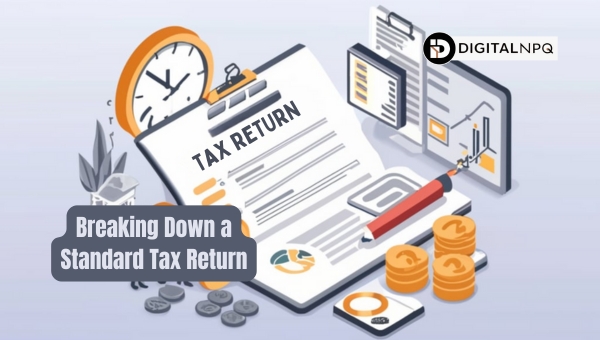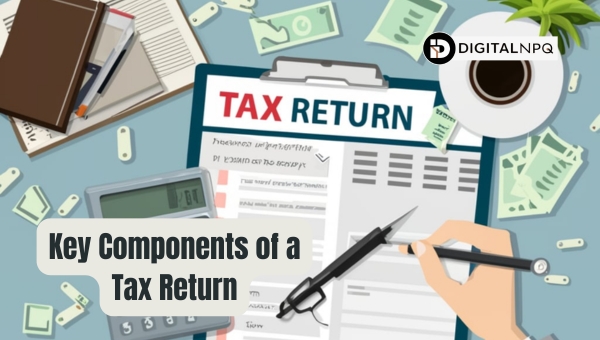Typical Tax Return: Your Best Guide to Filing Like a Pro

Filing a typical tax return can be daunting, but it doesn’t have to be. In this guide, we’ll break down everything you need to know. From understanding the key components of a tax return, calculating refunds, and tracking them, to solving common issues and following best practices for filing, we’ve got you covered.
Whether you’re new to tax returns or looking to refine your process, this comprehensive guide will help you navigate your tax return with confidence. Let’s dive in and make tax season a breeze!
Breaking Down a Standard Tax Return
A tax return is an essential annual document that individuals must file to report their income, claim deductions and credits, and calculate their tax liability. It includes personal information, such as name, address, and social security number, as well as details about various income sources like wages, salaries, tips, interest, dividends, and business income.

Additionally, a tax return lists applicable deductions and credits that reduce taxable income and tax owed. Filing can be done electronically or on paper, though e-filing is often preferred for its speed and efficiency. Accurate reporting is crucial to ensure compliance with tax laws and to maximize potential refunds.
Key Components of a Tax Return
Filing a tax return can seem complex, but breaking it down into key components makes the process manageable. From reporting various types of income to understanding deductions and credits, each part plays a crucial role in determining your tax liability. Let’s delve into the main sections you’ll encounter.

Income Information
When reporting income on your tax return, it’s essential to include all sources. This ensures compliance and accuracy. Here are some common types of income to report:
- Wages and Salaries: Earnings from employment.
- Interest and Dividends: Income from bank accounts and investments.
- Business Income: Profits from self-employment or business ventures.
- Rental Income: Earnings from renting out property.
- Capital Gains: Profits from selling assets like stocks or real estate.
- Other Income: Tips, alimony, and miscellaneous earnings.
Deductions and Credits
Deductions and credits are valuable tools that can reduce your taxable income and the amount of tax you owe. Understanding these can help you optimize your tax return:
- Mortgage Interest: Deduct interest paid on a home mortgage.
- Charitable Contributions: Deduct donations to qualifying charitable organizations.
- Medical Expenses: Deduct out-of-pocket medical costs that exceed a certain percentage of your income.
- State and Local Taxes: Deduct state and local income, sales, and property taxes.
- Earned Income Tax Credit (EITC): A credit for low to moderate-income working individuals and families.
- Education Credits: Credits for tuition and other educational expenses, such as the American Opportunity Credit and Lifetime Learning Credit.
By understanding these key components, you can navigate your tax return with confidence and ensure all necessary information is accurately reported.
Calculating Tax Refunds
Determining your tax refund can seem complex, but understanding the process makes it easier. We’ll explore how to estimate your refund and highlight common deductions and credits that influence your calculations.

Estimating Your Refund
Estimating your potential tax refund involves assessing your income, deductions, and credits. You can use online calculators provided by the IRS or various tax software. These tools require inputting your income details and deductions to give a rough estimate.
Additionally, seeking help from tax professionals can provide a more accurate calculation as they consider all possible factors and ensure compliance with tax laws.
Common Deductions and Credits
Several common deductions and credits can significantly affect your refund calculation:
- Standard Deduction: A fixed amount that reduces your taxable income.
- Mortgage Interest: Interest paid on home loans can be deducted.
- Charitable Contributions: Donations made to qualified organizations can be claimed.
- Earned Income Tax Credit (EITC): A credit for low to moderate-income working individuals.
- Education Credits: Credits like the American Opportunity Credit can reduce the amount of tax owed.
By understanding these elements, you can better navigate the tax return process and maximize your potential refund.
Also Read: IRS Stimulus Check Updates 2024: What You Should Know
Tracking Your Tax Refund
When it comes to tracking your tax refund, there are several resources and methods you can use for a smooth process.
Knowing how to track your refund ensures that you stay informed and can address any issues promptly. Let’s delve into some useful tools and options for monitoring your refund status.
Online Tools
Tracking your tax refund online is convenient and efficient. Here are some tools you can use:
- IRS “Where’s My Refund?” Tool: This tool provides updates on your refund status within 24 hours of e-filing.
- Tax Software Trackers: Many tax preparation software programs offer built-in tracking features.
- Mobile Apps: Apps like IRS2Go allow you to check your refund status from your smartphone.
Direct Deposit Options
Opting for direct deposit when receiving your tax refund offers several benefits:
- Speed: Direct deposits typically receive refunds faster than mailed checks.
- Security: Reduces the risk of lost or stolen checks.
- Convenience: Funds are deposited directly into your bank account without the need to visit a bank.
To set up direct deposit, you’ll need to provide your bank account and routing numbers on your tax return.
Common Issues and Solutions
When dealing with tax returns, various issues can arise that may cause confusion or concern. Understanding these common problems and knowing how to address them can make the process smoother and less stressful. Let’s delve into two frequent issues and their solutions.
If Your Refund Isn’t What You Expected
It’s not uncommon for taxpayers to find that their actual refund differs from what they anticipated. This can happen due to several reasons:
- Errors in Reporting: Mistakes in reporting income or deductions can lead to discrepancies.
- Tax Law Changes: Recent changes in tax laws might affect your refund without your knowledge.
- Withholding Adjustments: Changes in your withholding throughout the year can impact your overall refund.
To resolve these issues, it’s important to:
- Double-check Your Return: Review your tax return for any mistakes or omissions.
- Consult a Professional: If you’re unsure where the discrepancy lies, seeking advice from a tax professional can provide clarity.
- Update Your Records: Ensure your records are up-to-date to avoid future discrepancies.
Where’s My Refund?
If your refund is delayed or missing, there are steps you can take to track it down:
- Use the IRS “Where’s My Refund?” Tool: This online resource allows you to check the status of your refund.
- Contact the IRS: If the online tool doesn’t provide the information you need, calling the IRS directly can help.
- Verify Your Information: Make sure that all the information you submitted on your tax return is accurate and complete.
By following these steps, you can address common issues and ensure that your tax return process goes as smoothly as possible.
Also Read: Veterans Affairs Benefits Stimulus Check: Essential Guide
Best Practices for Filing
When it comes to filing your typical tax return, adopting best practices can make the process smoother and more efficient. We’ll dive into the essentials of organizing your documents and explore the differences between electronic filing and traditional paper filing.
Preparing Your Documents
Organizing your documents before filing taxes is crucial to ensure accuracy and avoid delays. Here are some steps to help you get started:
- Gather Income Statements: Collect W-2s, 1099s, and any other income statements.
- Track Deductions and Credits: Keep records of deductible expenses like mortgage interest, charitable contributions, and medical expenses.
- Maintain Receipts: Store receipts for all deductible expenses in one place.
- Use a Checklist: Create a checklist to ensure you’ve gathered all necessary documents.
Filing Electronically vs. Paper
Deciding between electronic filing and paper filing can impact the ease and speed of processing your tax return. Here are the pros and cons of each method:
- Electronic Filing:
- Pros:
- Faster processing and quicker refunds.
- Immediate confirmation of receipt.
- Reduced risk of errors.
- Cons:
- Requires internet access and basic computer skills.
- Potential security concerns with online data.
- Pros:
- Paper Filing:
- Pros:
- No need for internet or computer access.
- Familiar and straightforward for those uncomfortable with technology.
- Cons:
- Slower processing time.
- Higher chance of errors and lost documents.
- No immediate confirmation of receipt.
- Pros:
FAQs
How much do you typically get back in taxes?
The amount you get back in taxes varies widely based on income, deductions, and credits. On average, taxpayers receive a few thousand dollars, but this can differ significantly.
What is a decent tax return?
A decent tax return usually means getting back a substantial portion of your withheld taxes. This often includes refunds from tax credits and deductions, which can lower your overall tax liability.
What is the biggest tax return ever?
While official records aren’t usually disclosed, some taxpayers have received refunds in the tens of thousands due to large deductions and credits applicable to their specific financial situations.
Conclusion
Filing a typical tax return can seem complicated, but understanding its components and processes can make it more manageable. From reporting income to claiming deductions and credits, each step is crucial for accurate tax filing and maximizing potential refunds.
Utilizing online tools and opting for direct deposit can streamline the process even further. By staying organized and informed, taxpayers can avoid common issues and ensure a smooth filing experience. To explore more insightful articles on tax preparation and other financial topics, visit our blog and stay informed!
